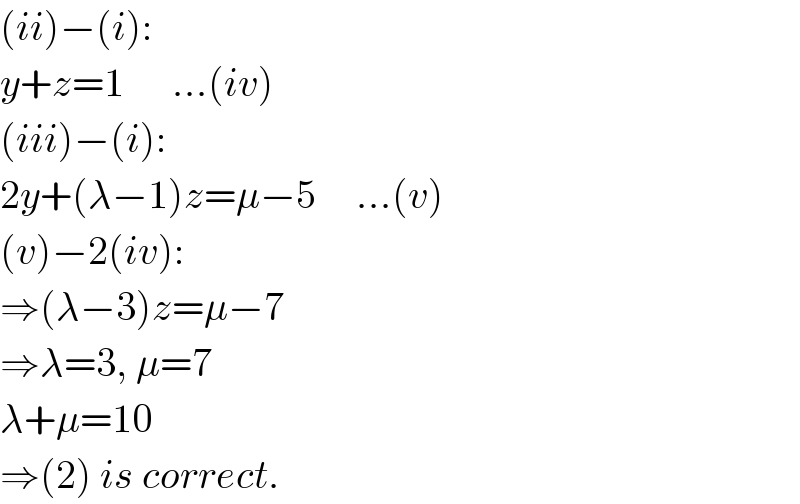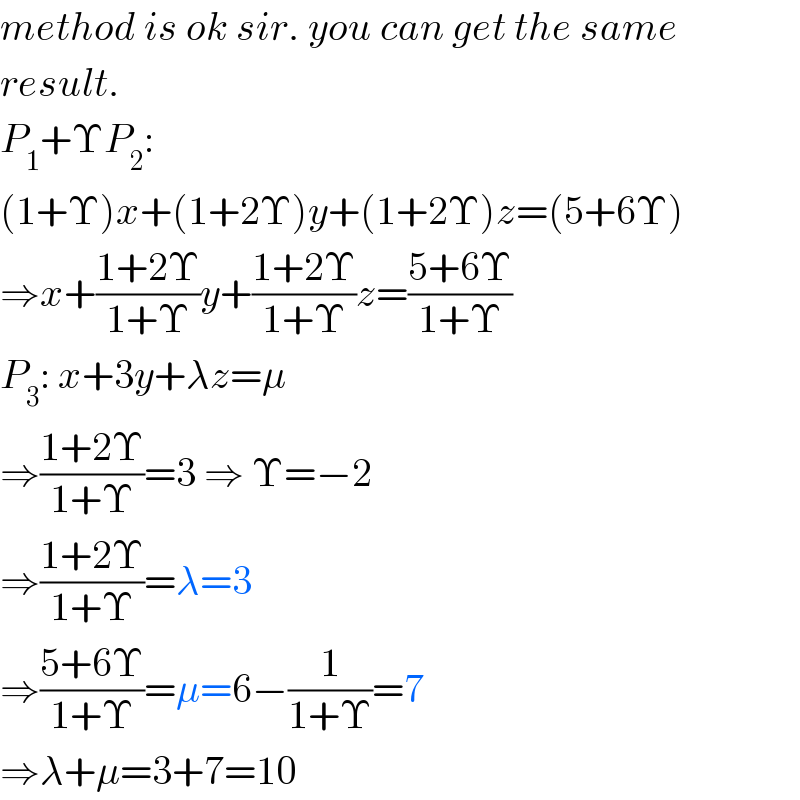Question Number 57698 by rahul 19 last updated on 10/Apr/19

Commented by rahul 19 last updated on 10/Apr/19

$$\mathrm{3}{rd}\:{plane}\:{can}\:{be}\:{written}\:{as}\:: \\ $$$${P}_{\mathrm{1}} +\Upsilon{P}_{\mathrm{2}} \:,\:{how}\:{to}\:{find}\:\:\Upsilon? \\ $$$${here}\:\lambda=\mathrm{3},\mu=\mathrm{7}\:{but}\:{then}\:\Upsilon\:{is}\:{not}\:{unique}! \\ $$
Answered by mr W last updated on 10/Apr/19

$$\left({ii}\right)−\left({i}\right): \\ $$$${y}+{z}=\mathrm{1}\:\:\:\:\:\:…\left({iv}\right) \\ $$$$\left({iii}\right)−\left({i}\right): \\ $$$$\mathrm{2}{y}+\left(\lambda−\mathrm{1}\right){z}=\mu−\mathrm{5}\:\:\:\:\:…\left({v}\right) \\ $$$$\left({v}\right)−\mathrm{2}\left({iv}\right): \\ $$$$\Rightarrow\left(\lambda−\mathrm{3}\right){z}=\mu−\mathrm{7} \\ $$$$\Rightarrow\lambda=\mathrm{3},\:\mu=\mathrm{7} \\ $$$$\lambda+\mu=\mathrm{10} \\ $$$$\Rightarrow\left(\mathrm{2}\right)\:{is}\:{correct}. \\ $$
Commented by rahul 19 last updated on 10/Apr/19
Sir, what's the problem in my method?
Commented by mr W last updated on 10/Apr/19

$${method}\:{is}\:{ok}\:{sir}.\:{you}\:{can}\:{get}\:{the}\:{same} \\ $$$${result}. \\ $$$${P}_{\mathrm{1}} +\Upsilon{P}_{\mathrm{2}} : \\ $$$$\left(\mathrm{1}+\Upsilon\right){x}+\left(\mathrm{1}+\mathrm{2}\Upsilon\right){y}+\left(\mathrm{1}+\mathrm{2}\Upsilon\right){z}=\left(\mathrm{5}+\mathrm{6}\Upsilon\right) \\ $$$$\Rightarrow{x}+\frac{\mathrm{1}+\mathrm{2}\Upsilon}{\mathrm{1}+\Upsilon}{y}+\frac{\mathrm{1}+\mathrm{2}\Upsilon}{\mathrm{1}+\Upsilon}{z}=\frac{\mathrm{5}+\mathrm{6}\Upsilon}{\mathrm{1}+\Upsilon} \\ $$$${P}_{\mathrm{3}} :\:{x}+\mathrm{3}{y}+\lambda{z}=\mu \\ $$$$\Rightarrow\frac{\mathrm{1}+\mathrm{2}\Upsilon}{\mathrm{1}+\Upsilon}=\mathrm{3}\:\Rightarrow\:\Upsilon=−\mathrm{2} \\ $$$$\Rightarrow\frac{\mathrm{1}+\mathrm{2}\Upsilon}{\mathrm{1}+\Upsilon}=\lambda=\mathrm{3} \\ $$$$\Rightarrow\frac{\mathrm{5}+\mathrm{6}\Upsilon}{\mathrm{1}+\Upsilon}=\mu=\mathrm{6}−\frac{\mathrm{1}}{\mathrm{1}+\Upsilon}=\mathrm{7} \\ $$$$\Rightarrow\lambda+\mu=\mathrm{3}+\mathrm{7}=\mathrm{10} \\ $$
Commented by rahul 19 last updated on 11/Apr/19

$${Thanks}\:{Sir}. \\ $$$${I}\:{was}\:{doing}\:\mathrm{1}+\Upsilon=\mathrm{1}\:,\:\mathrm{1}+\mathrm{2}\Upsilon=\mathrm{3}\:{i}.{e} \\ $$$${i}\:{didn}'{t}\:{make}\:{coeff}.\:{of}\:{x}\:{as}\:\mathrm{1}. \\ $$
Commented by mr W last updated on 11/Apr/19

$${the}\:{coefficients}\:{must}\:{not}\:{be}\:{the}\:{same}, \\ $$$${only}\:{the}\:{ratios}\:{between}\:{them}\:{must}\:{be} \\ $$$${the}\:{same}.\: \\ $$
Commented by rahul 19 last updated on 11/Apr/19

$$\left.{Ok}\:{Sir}!:\right) \\ $$
